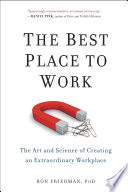

The foundation of a great workplace is a positive culture that fosters respect, trust, and collaboration. This idea emphasizes the importance of cultivating a culture where employees feel valued and engaged. A positive workplace culture not only enhances employee satisfaction but also drives productivity and innovation. The book discusses various strategies for leaders to establish an inclusive environment, such as promoting open communication, recognizing achievements, and encouraging teamwork. By prioritizing culture, organizations can attract and retain top talent, ultimately leading to better business outcomes.
Continue readingEmployee engagement is a critical factor in determining the success of an organization. The book highlights that engaged employees are more productive, motivated, and loyal. It stresses the need for leaders to empower their employees by giving them autonomy, involving them in decision-making processes, and providing opportunities for professional growth. The idea is that when employees feel they have a stake in the company’s success, they are more likely to go above and beyond in their roles. The book offers practical techniques for fostering engagement, such as regular feedback and mentorship programs.
Continue readingDiversity and inclusion are not just buzzwords; they are essential components of a thriving workplace. The book argues that diverse teams bring a variety of perspectives that enhance creativity and problem-solving. It encourages organizations to actively pursue diversity in hiring practices and to create an inclusive environment where all voices are heard. The narrative illustrates how companies that embrace diversity tend to outperform their competitors and adapt better to market changes. The book provides actionable steps for integrating diversity into the company’s core values and practices.
Continue readingThe importance of work-life balance is a recurring theme in the book. It discusses how organizations can promote well-being by offering flexible work arrangements, mental health resources, and support systems. The idea is that when employees feel balanced in their personal and professional lives, they are more engaged and productive at work. The book provides insights into how leaders can create policies that support work-life balance, such as remote work options and wellness programs, ultimately leading to a healthier workforce.
Continue readingIn an ever-changing business landscape, continuous learning is crucial for both employees and organizations. The book emphasizes the need for companies to invest in training and development programs that equip employees with new skills and knowledge. It discusses various approaches to fostering a learning culture, such as providing access to online courses, encouraging mentorship, and creating opportunities for cross-functional collaboration. By prioritizing continuous learning, organizations can stay competitive and adapt to industry changes while also enhancing employee satisfaction.
Continue readingRecognition and reward systems play a vital role in motivating employees. The book outlines how organizations can implement effective recognition programs that acknowledge individual and team contributions. It discusses the importance of timely and meaningful recognition, as well as the impact of rewards on employee morale. The narrative suggests various methods for recognition, ranging from informal shout-outs to formal awards, and emphasizes that a well-structured recognition program can lead to higher levels of engagement and retention.
Continue readingEffective leadership is essential for creating and maintaining a great workplace. The book highlights the importance of leadership development programs that identify and nurture future leaders within the organization. It discusses strategies for succession planning, ensuring that there is a pipeline of talent ready to step into leadership roles when needed. The idea is that organizations must invest in their leaders to cultivate a culture of accountability, vision, and support, ultimately driving the organization towards its goals.
Continue reading